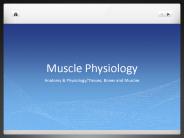Muscle Physiology - PowerPoint PPT Presentation
1 / 32
Title:
Muscle Physiology
Description:
Muscle Physiology Chapter 1 Objectives Describe the micro and macrostructure of muscle Describe the sliding filament theory Differentiate types of muscle actions ... – PowerPoint PPT presentation
Number of Views:106
Avg rating:3.0/5.0
Title: Muscle Physiology
1
Muscle Physiology
- Chapter 1
2
Objectives
- Describe the micro and macrostructure of muscle
- Describe the sliding filament theory
- Differentiate types of muscle actions
- Discuss factors that affect force production
3
Huxley?
4
KEY POINT
- The muscular system is the organ system
responsible for movement. Muscles develop
tension, causing bones to act as levers and
rotate around an axis.
5
(No Transcript)
6
Neuromuscular Components
- Neuromuscular junction- the point where a motor
neuron joins muscle fibers, the motor end plate - Motor unit- a motor neuron and all the muscle
fibers it innervates - All or none law- all the muscle fibers in a motor
unit contract, or none contract
7
(No Transcript)
8
(No Transcript)
9
(No Transcript)
10
Structure of a Muscle Cell
- Sarcoplasm- the cytoplasm of a muscle fiber,
contains mitochondria, sarcoplasmic reticulum - Sarcomere- smallest contractile unit of muscle
tissue - Sarcoplasmic Reticulum contains calcium.
11
(No Transcript)
12
(No Transcript)
13
(No Transcript)
14
(No Transcript)
15
(No Transcript)
16
Structure of a Muscle Cell
- Myofibrils- long fibers in the sarcoplasm of
muscle cells - Actin (thin)
- Myosin (thick)
- Crossbridges- globular heads on the myosin
molecules
17
(No Transcript)
18
Structure of Skeletal Muscle
- Contractile proteins- actin and myosin
- Myofibril- muscle fiber, one muscle cell
- Regulatory proteins- troponin and tropomyosin
- Sarcomere- Z-line to Z-line
- Sarcoplasmic reticulum/T-tubules-
communications system in the muscle cell
19
(No Transcript)
20
Sliding Filament Theory of Muscle Contraction
- 1. Resting phase- calcium is segregated in the
sarcoplasmic reticulum (SR), few crossbridges are
attached, the muscle cell is at rest
21
Sliding Filament Theory of Muscle Contraction
- 2. Excitation phase- contraction coupling phase-
calcium ions are released from the SR, troponin
and tropomyosin undergo a conformational change,
allowing actin to bind to myosin, causing flexion
of the myosin head
22
Sliding Filament Theory of Muscle Contraction
- 3. Contraction phase- ATP causes myosin heads to
detach from actin, ATP is hydrolized which
cocks the myosin head, the myosin head attaches
to the next active site
23
Sliding Filament Theory of Muscle Contraction
- 4. Recharge phase- as long as ATP is present to
break the attraction of actin to myosin, and
calcium is present, the cycle continues causing
tension to develop in the muscle
24
Sliding Filament Theory of Muscle Contraction
- 5. Relaxation phase- stimulation from the motor
nerve stops, calcium is re-segregated into the
sarcoplasmic reticulum, troponin and tropomyosin
return to their original shape and block the
attraction of actin and myosin, the muscle
returns to the resting unbound state
25
Cycle Time
26
Sliding Filament Animation
- http//www.sci.sdsu.edu/movies/actin_myosin_gif.ht
ml
27
(No Transcript)
28
(No Transcript)
29
(No Transcript)
30
(No Transcript)
31
Summary of Muscle Contraction
- Acetylcholine (ACH) released from terminal
portion of motor neuron - ACH crosses the gap at the neuromuscular junction
- Muscle fiber membrane depolarizes through
transverse tubules to the sarcoplasmic reticulum
32
Next Class
- Finish Chapter 1































